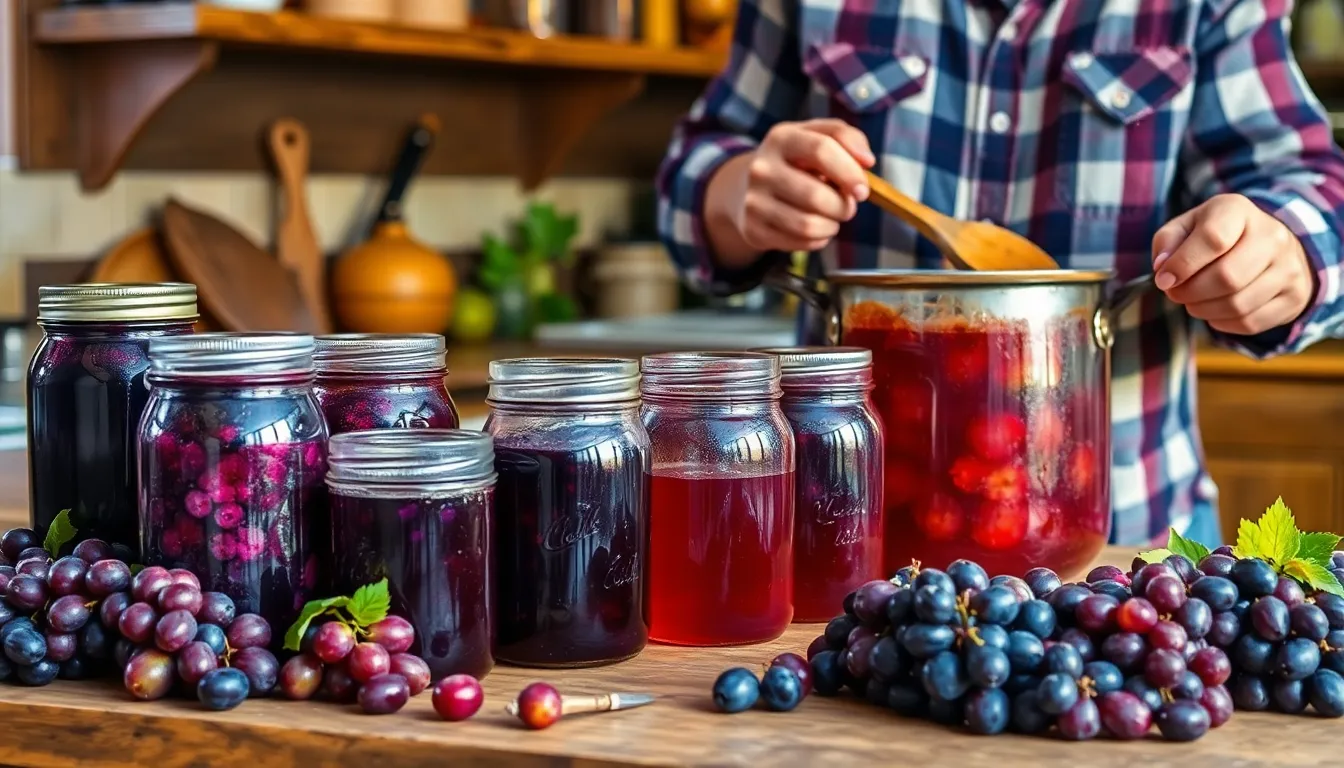Have you ever tasted the sweet-tart magic of muscadine jelly? This Southern treasure transforms wild grapes into liquid gold that’ll elevate your breakfast table instantly.
Muscadine jelly captures the essence of late summer in the South, when these thick-skinned native grapes reach perfect ripeness. With their distinctive musky aroma and rich flavor, muscadines create a jelly that’s unlike anything you’ll find in grocery stores. This deep purple spread strikes the perfect balance between sweetness and tanginess.
You’ll love how versatile this homemade jelly is – spread it on hot biscuits, pair it with sharp cheddar, or use it to glaze a holiday ham. The process might seem intimidating at first, but our step-by-step recipe makes it surprisingly simple. Once you’ve mastered muscadine jelly, you’ll find yourself looking forward to grape season every year.
What Is Muscadine Jelly?
Muscadine jelly is a prized Southern preserve made from the juice of muscadine grapes (Vitis rotundifolia) that thrive throughout the southeastern United States. These thick-skinned native grapes develop a deep purple or bronze color when fully ripe and possess a distinctive musky sweetness that translates beautifully into jelly.
Unlike conventional grape varieties, muscadines have a higher pectin content which helps the jelly set properly. The resulting preserve captures the essence of these wild grapes – offering a complex flavor profile that balances sweetness with subtle tartness and earthy undertones.
Traditional muscadine jelly features a gorgeous jewel-tone color ranging from deep purple to ruby red depending on the grape varieties used. The texture is smooth and spreadable with a glistening appearance that catches the light beautifully when spread on warm bread or biscuits.
Muscadine jelly stands apart from mass-produced grape jellies thanks to its authentic regional character and intense flavor concentration. Many Southern families pass down cherished muscadine jelly recipes through generations, with each household often developing their own signature method for achieving the perfect set and flavor balance.
The transformation from fresh grapes to preserved jelly not only captures the fleeting seasonal flavor of muscadines but also extends their enjoyment throughout the year. This preservation technique reflects the traditional Southern approach to making the most of seasonal bounty.
Why You’ll Love This Muscadine Jelly Recipe
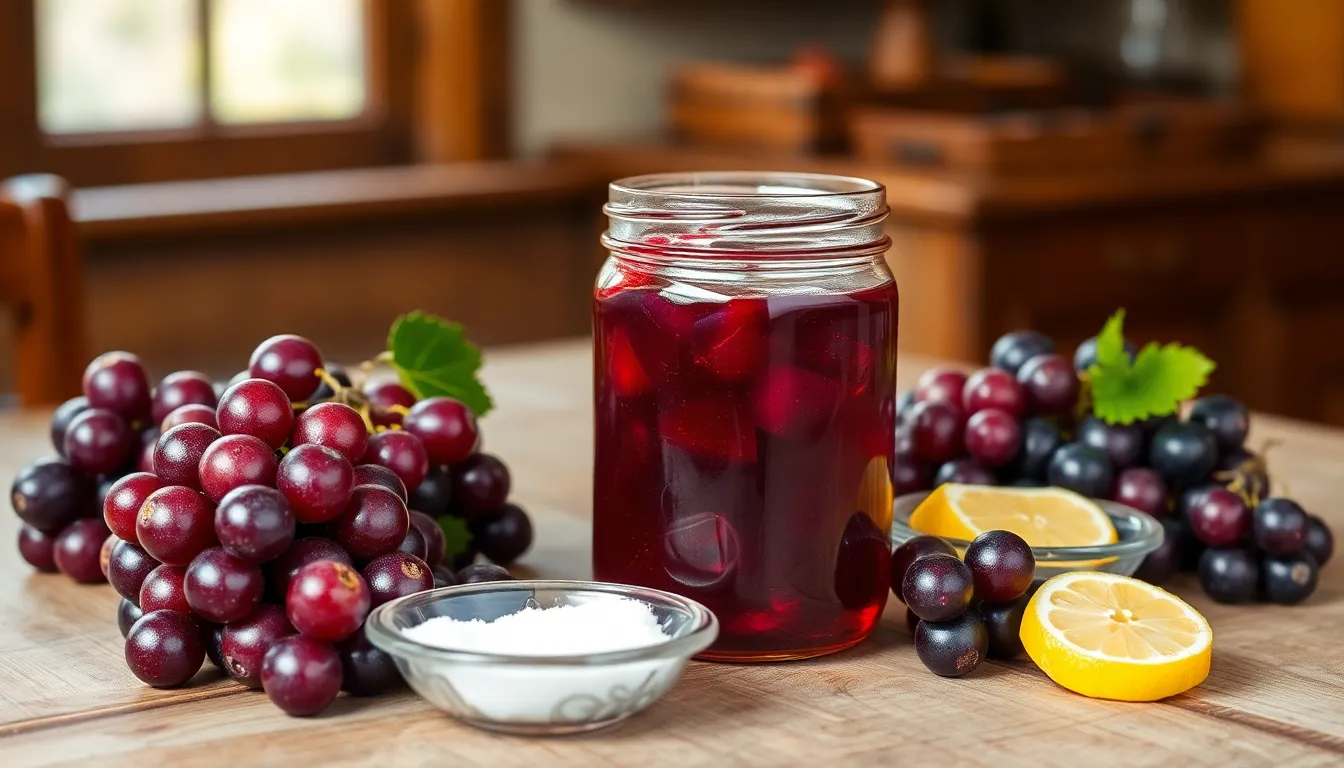
This muscadine jelly recipe transforms wild Southern grapes into a spectacular homemade preserve you’ll want to make every season. The naturally high pectin content in muscadines creates a perfect set without commercial additives.
Your family will appreciate the pure grape flavor that store-bought jellies simply cannot match. The stunning jewel-toned color—ranging from deep purple to ruby red—makes this jelly as beautiful as it is delicious.
Making this recipe requires minimal ingredients: just muscadines, sugar, and lemon juice. The process honors traditional Southern preservation methods while remaining accessible for modern home cooks.
Even novice canners will find success with these straightforward instructions. The recipe yields multiple jars to enjoy throughout the year or share as thoughtful handmade gifts.
Versatility stands out as another advantage—spread this jelly on hot biscuits, pair it with sharp cheeses, glaze meats, or use as a sophisticated filling for pastries. The distinctive sweet-tart flavor profile enhances both sweet and savory dishes.
This recipe allows you to capture peak seasonal flavor at its finest moment. Each spoonful delivers the authentic taste of muscadine grapes that cannot be commercially replicated.
Equipment Needed
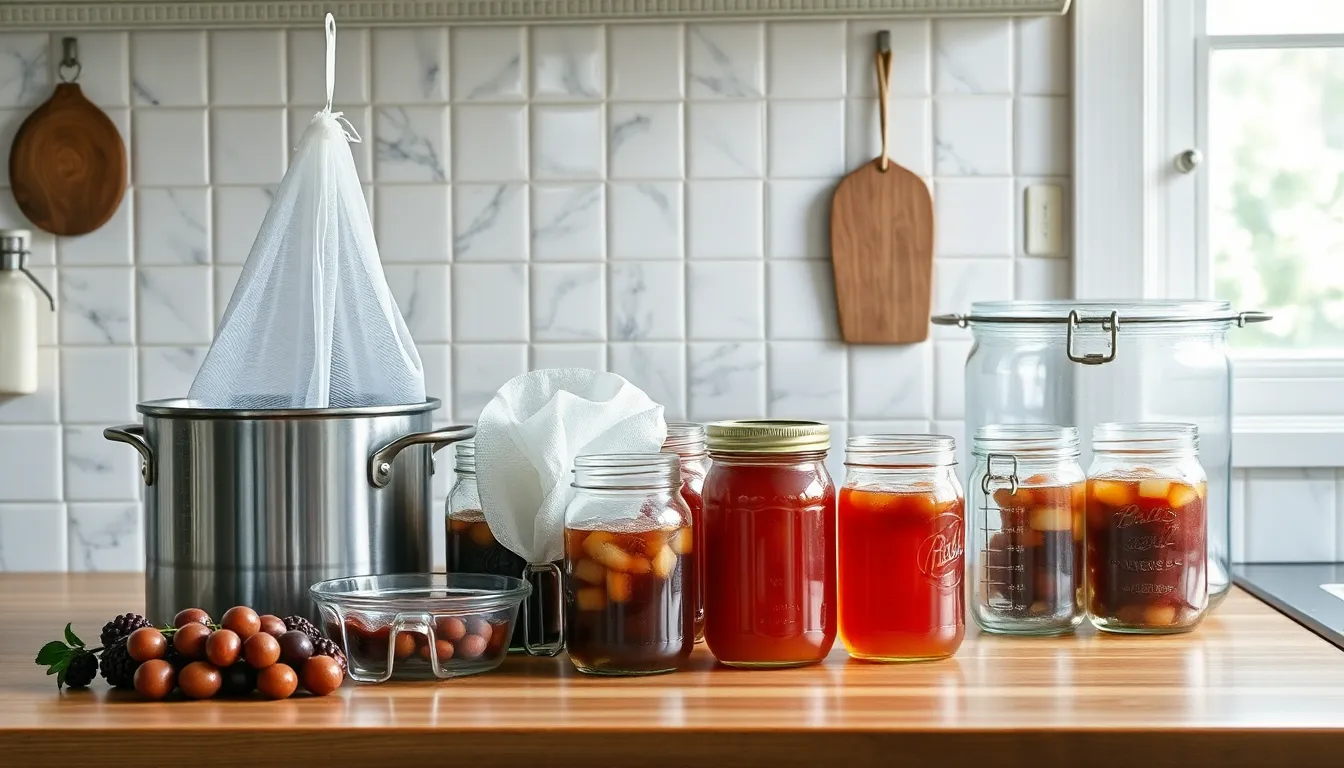
Successful muscadine jelly making requires proper equipment to extract juice transform it into a beautifully set preserve. Gather these essential tools before starting your jelly-making adventure:
- Large stainless steel or enamel pot (at least 8-quart capacity)
- Food mill or jelly bag for straining
- Potato masher or wooden spoon for crushing grapes
- Digital kitchen scale for accurate measurements
- Liquid measuring cups for juice
- Dry measuring cups for sugar
- Canning funnel with wide mouth
- Ladle for transferring hot jelly
- 8-ounce canning jars with new lids and bands
- Large water bath canner with rack
- Jar lifter for safely removing hot jars
- Bubble remover tool or plastic knife
- Clean kitchen towels
- Timer for processing
- Candy thermometer or digital thermometer that reaches 220°F
For the straining process specifically you will need either a jelly bag setup with stand or a large fine-mesh strainer lined with cheesecloth positioned over a large bowl. This equipment ensures proper juice extraction without pulp or seeds making their way into your finished product.
Having all equipment ready and sterilized before beginning will streamline your jelly-making process and help ensure food safety standards are met. Proper tools make the difference between a frustrating experience and a smooth jelly-making session that yields beautiful consistent results.
Ingredients For Muscadine Jelly

Creating muscadine jelly requires just a handful of simple ingredients that allow the natural flavor of these Southern grapes to shine through. The process involves first extracting the juice from the muscadines before transforming it into a beautifully set jelly.
For The Juice
- 5 pounds ripe muscadine grapes (purple or bronze varieties)
- 1 cup water
- ¼ cup lemon juice (freshly squeezed yields best results)
For The Jelly
- 4 cups muscadine juice (from the extraction process)
- 5 cups granulated sugar
- 1 package (1.75 oz) powdered pectin OR 3 tablespoons powdered pectin
- ¼ teaspoon butter (optional, helps reduce foaming)
- ½ teaspoon vanilla extract (optional, enhances flavor)
How To Make Muscadine Jelly
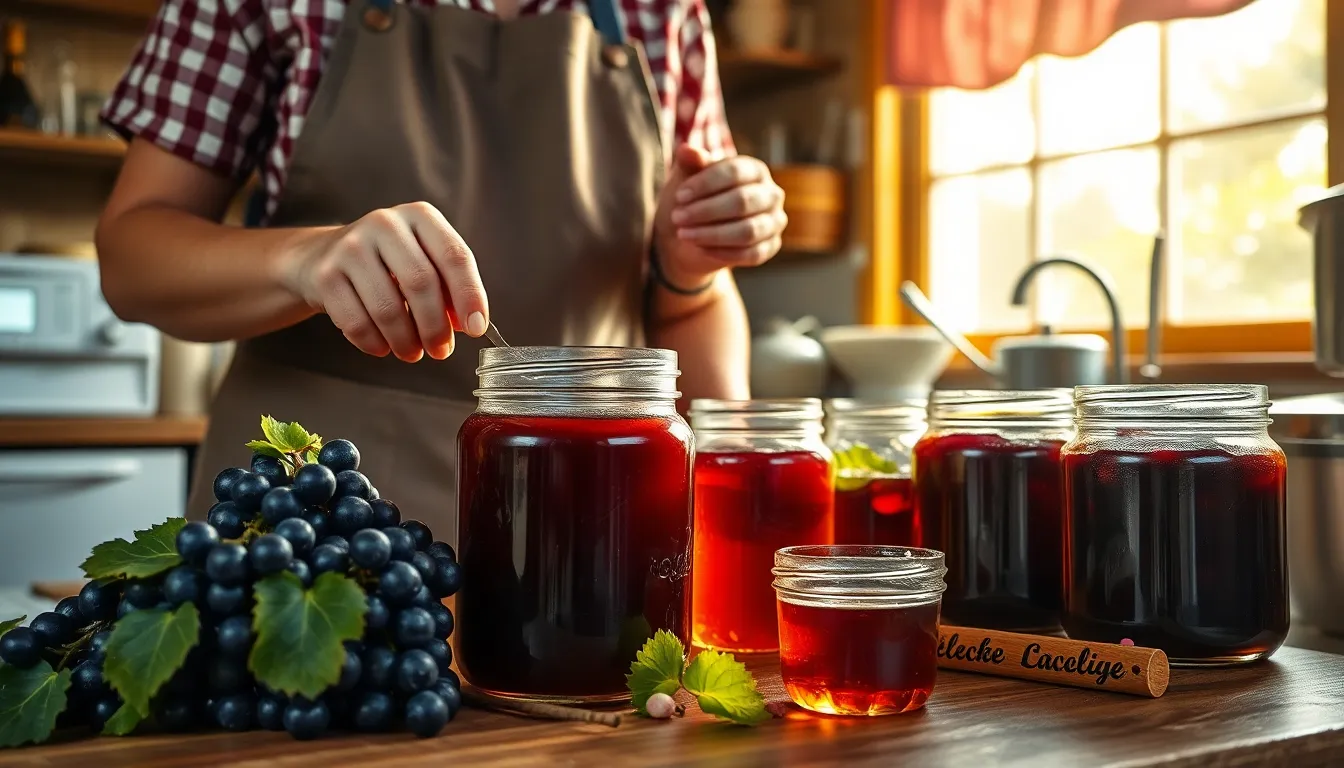
Creating muscadine jelly transforms these Southern wild grapes into a stunning preserve that captures their unique flavor. Follow these step-by-step instructions for perfect homemade jelly every time.
Preparing The Muscadines
Begin by rinsing your muscadines thoroughly under cool running water to remove any dirt or debris. Sort through the grapes and discard any that show signs of mold or appear overripe. Place the clean muscadines in a large pot and slightly crush them with a potato masher to help release their juices. Add 1 cup of water to the pot to prevent scorching during the initial cooking process. Heat the muscadines over medium heat until they come to a gentle boil then reduce to a simmer. Cook for about 10 minutes or until the muscadines have softened and burst open releasing their juice. You’ll notice the thick skins separating from the pulp as they cook.
Extracting The Juice
Transfer the cooked muscadines to a food mill positioned over a large bowl or use a jelly bag suspended over a container. If using a jelly bag allow the juice to drip naturally without squeezing to ensure the clearest jelly. This dripping process may take several hours or even overnight for the best results. For a quicker method press the cooked grapes through a food mill to separate the juice from the skins and seeds. After collecting the juice measure it precisely. You should have approximately 4 cups of juice from 5 pounds of muscadines. Pour the measured juice into a large saucepan and add the lemon juice which provides the necessary acidity for proper jelling.
Making The Jelly
Pour your measured muscadine juice into a large heavy-bottomed pot. Stir in the pectin according to package directions and bring the mixture to a full rolling boil over high heat. Add 1/2 teaspoon of butter to reduce foaming if desired. Once boiling add all the sugar at once stirring constantly to dissolve it completely. Return the mixture to a full rolling boil that cannot be stirred down. Boil hard for exactly 1 minute while stirring continuously. Remove the pot from heat immediately and skim off any foam with a metal spoon. Test the jelly’s consistency by placing a small amount on a chilled plate and checking if it sets. The jelly should wrinkle when pushed with your finger after cooling for a minute.
Processing The Jars
Ladle the hot jelly immediately into sterilized jars leaving 1/4 inch headspace at the top. Wipe the jar rims with a clean damp cloth to remove any sticky residue that might prevent proper sealing. Place the lids on the jars and screw on the bands until fingertip tight. Process the filled jars in a boiling water bath for 5 minutes for half-pint jars or 10 minutes for pint jars. Start timing only when the water returns to a full boil. Remove jars carefully using jar lifters and place them on a towel-covered countertop away from drafts. Allow the jars to cool undisturbed for 24 hours. You’ll hear a satisfying “ping” sound as each jar seals properly. Check seals by pressing on the center of each lid – properly sealed lids will not flex. Store any unsealed jars in the refrigerator and use within 3 weeks. Properly sealed jars can be stored in a cool dark place for up to a year.
Tips For Perfect Muscadine Jelly

Test for Proper Setting
Always keep a small plate in your freezer while making jelly. When you think your jelly has reached the setting point place a small spoonful on the cold plate and return it to the freezer for one minute. Push your finger through the jelly sample – if it wrinkles and holds its shape your jelly is ready. Should it remain runny continue cooking for another few minutes then test again.
Select the Perfect Grapes
Choose muscadines at peak ripeness for optimal flavor and natural pectin content. The grapes should be plump firm and deeply colored whether purple or bronze varieties. Avoid using underripe fruit which lacks flavor or overripe grapes that may produce cloudy jelly. For the most vibrant color use a mix that’s predominantly purple muscadines.
Properly Extract the Juice
Patience during the juice extraction process yields superior results. Allow your crushed muscadines to simmer gently rather than boiling vigorously which can create a bitter taste. When straining avoid pressing or squeezing the pulp through your jelly bag as this introduces solids that cloud your finished product. Let gravity do the work overnight for crystal clear juice.
Measure Precisely
Jelly making requires exact measurements for consistent results. Use standard measuring cups specifically designed for dry ingredients when measuring sugar and liquid measuring cups for the juice. Altering the sugar-to-juice ratio can prevent proper setting and affect preservation. Follow the recipe quantities exactly especially for your first few batches.
Watch for the Gel Stage
Learn to recognize visual cues that indicate your jelly has reached the gel stage. Beyond the freezer plate test watch how the mixture drops from a spoon – when it forms two drops that flow together and sheet off the spoon the jelly is ready. The mixture will also thicken noticeably and may begin to show large bubbles that pop more slowly.
Prevent Crystallization
To avoid sugar crystallization in your jelly stir the mixture only until sugar dissolves completely. Once you reach the boiling stage minimize stirring to prevent crystal formation. Adding a teaspoon of butter reduces foam and helps prevent crystallization. For long-term storage ensure jars are properly sealed and store in a cool dark place.
Adjust for Pectin Content
Different batches of muscadines may contain varying amounts of natural pectin. If your grapes are very ripe you might need additional commercial pectin for proper setting. Including some slightly underripe muscadines in your mix naturally increases pectin content. Using one-fourth underripe to three-fourths fully ripe grapes creates an ideal balance of flavor and setting power.
Perfect Your Timing
Process filled jars immediately after filling while the jelly is still hot. Allowing the mixture to cool before processing can prevent proper sealing. Leave precisely ¼ inch headspace in each jar to allow for expansion during processing. Process jars for exactly the time specified in the recipe to ensure food safety without compromising texture.
Storage And Shelf Life

Properly sealed muscadine jelly can be stored at room temperature in a cool dark place such as a pantry or cupboard for up to 12 months. The high sugar content and proper water bath canning process create an environment that prevents spoilage while preserving the vibrant flavor of your homemade jelly.
Once you open a jar of muscadine jelly keep it refrigerated to maintain its quality. Refrigerated jars will stay fresh for approximately 3 weeks before the texture or flavor may begin to deteriorate. You might notice the bright jewel tone color fading slightly over time but this doesn’t affect the safety of your jelly.
For long term preservation store your sealed jars in a location away from direct sunlight and temperature fluctuations. Excessive heat or light exposure can cause your jelly to darken and potentially separate which affects the appearance but not necessarily the safety.
Always label your jars with the date of preparation to track their shelf life accurately. Before consuming stored jelly inspect for any signs of spoilage such as mold growth unusual odors or broken seals. If the metal lid pops up when pressed in the center or shows signs of bulging discard the jelly immediately as these indicate potential contamination.
Freezing muscadine jelly is also an option for extended storage. Pour cooled jelly into freezer safe containers leaving ½ inch headspace for expansion and store for up to 12 months. Thaw frozen jelly in the refrigerator before using for the best texture results.
| Storage Method | Expected Shelf Life | Storage Conditions |
|---|---|---|
| Unopened (pantry) | 12 months | Cool dark place |
| Opened (refrigerated) | 3 weeks | Refrigerator at 40°F or below |
| Frozen | 12 months | Freezer at 0°F or below |
Serving Suggestions
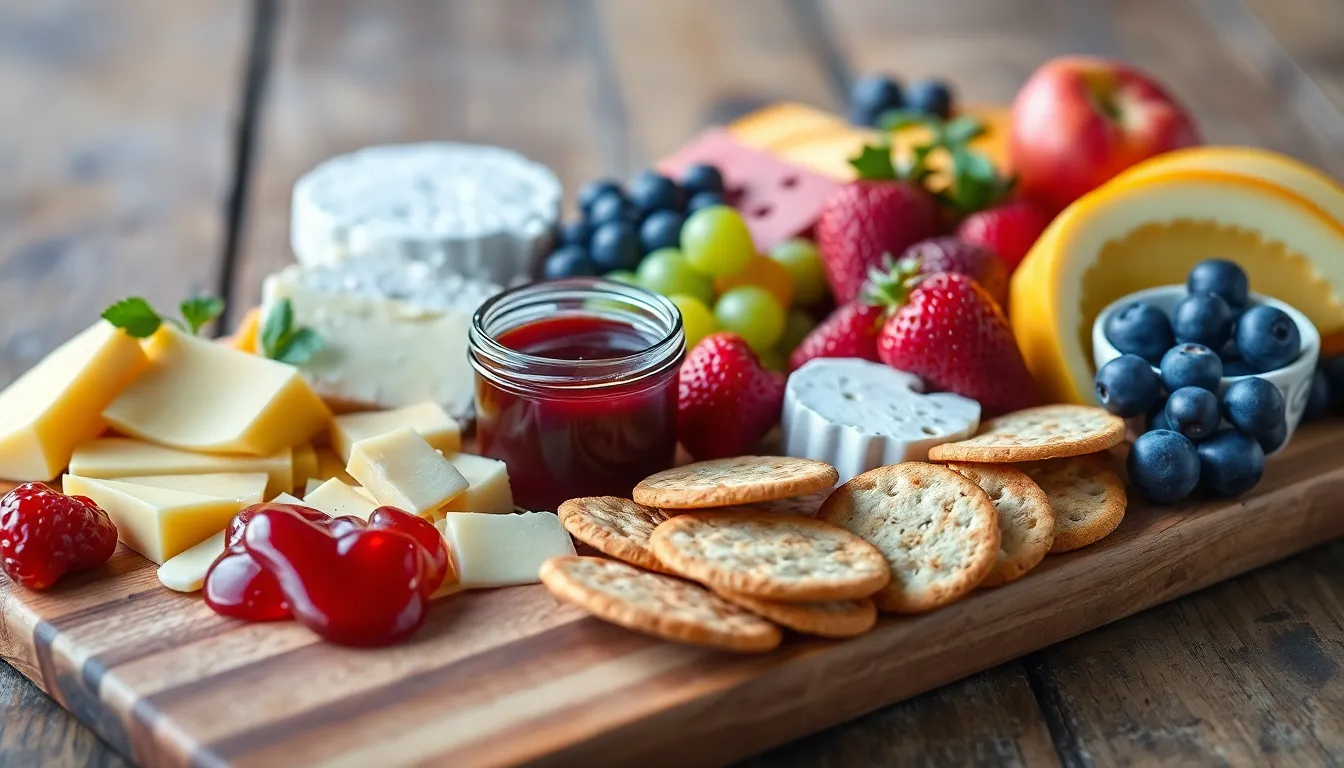
Muscadine jelly shines as a versatile addition to your culinary repertoire. Spread it generously on warm buttermilk biscuits or fluffy pancakes for a classic Southern breakfast experience. Try pairing this jewel-toned preserve with a charcuterie board featuring sharp cheddar smoked gouda or creamy brie cheese to create an impressive appetizer spread.
For a sophisticated snack combine muscadine jelly with cream cheese on crackers or crostini. Use it as a glaze for roasted pork tenderloin or grilled chicken by warming the jelly slightly and brushing it over the meat during the final cooking minutes. A spoonful swirled into plain yogurt transforms an ordinary breakfast into something special.
Muscadine jelly makes an excellent filling for thumbprint cookies or as a layer between vanilla cake tiers. Create a quick sauce for ice cream by heating the jelly with a splash of water until it reaches a pourable consistency. For a savory application brush it onto grilled vegetables during the last few minutes of cooking.
Transform ordinary PB&J sandwiches into gourmet treats with muscadine jelly’s distinctive grape flavor. Add a dollop to your morning oatmeal or stir it into hot tea for a fruity sweetener. Use it as a topping for cheesecake or mix a spoonful into vinaigrette dressing for a sweet-tart flavor profile on salads.
For an elegant dessert serve muscadine jelly alongside pound cake or angel food cake with fresh whipped cream. The jelly’s unique sweet-tart flavor complements both sweet and savory dishes making it an essential condiment for your table year-round.
Variations To Try
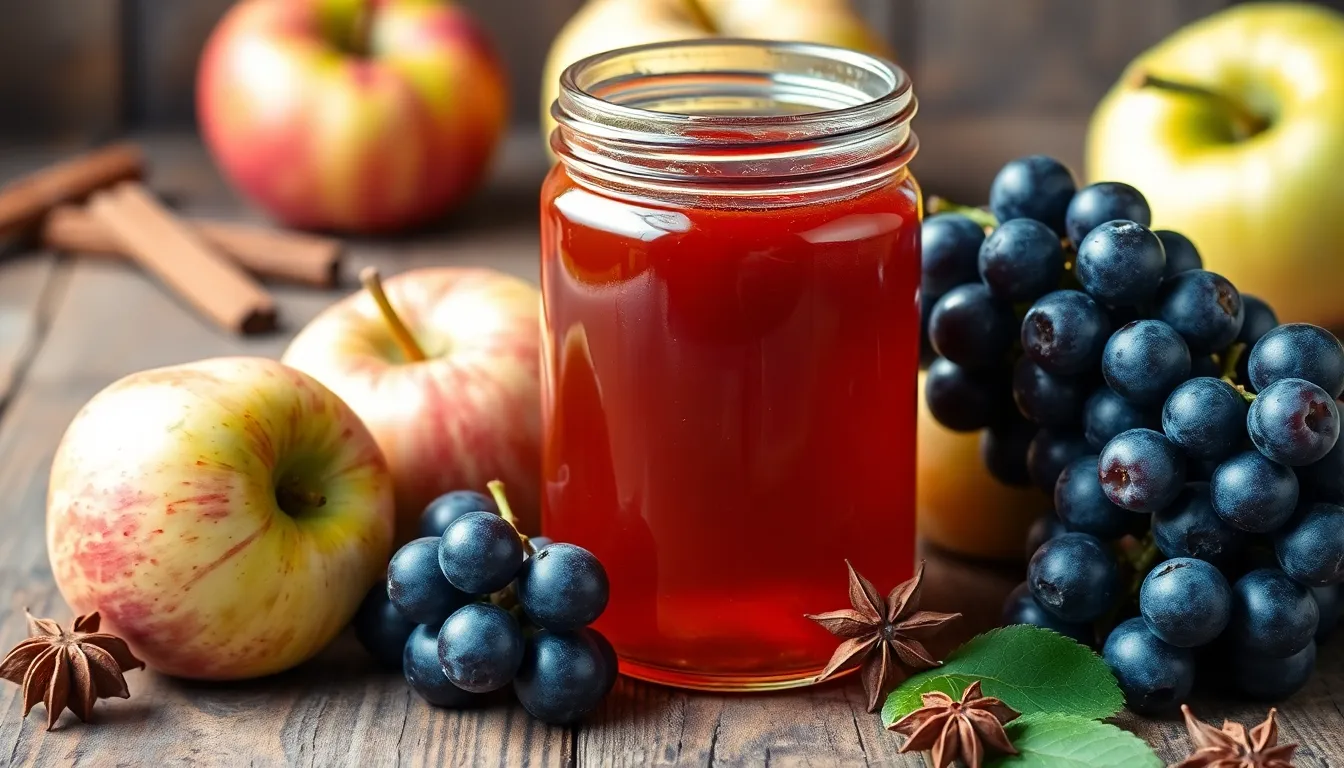
While traditional muscadine jelly is delicious on its own, experimenting with different flavor profiles can elevate this Southern preserve to new heights. These creative variations maintain the distinctive muscadine character while introducing complementary flavors.
Muscadine-Apple Jelly
Create a delightful fusion by combining muscadines with apples for a balanced jelly that captures the best of both fruits. Use 3 pounds of muscadines and 2 pounds of tart apples like Granny Smith for optimal flavor contrast. Prepare the muscadines as usual then core and roughly chop the apples before simmering them together. The apples add a subtle sweetness and mellow the intense muscadine flavor while contributing additional natural pectin. This variation works beautifully with cheese pairings and adds a sophisticated twist to your morning toast. For a smoother consistency you can strain the mixture twice through your jelly bag ensuring all apple particles are removed.
Spiced Muscadine Jelly
Transform your basic muscadine jelly into a warming fall treat by incorporating aromatic spices. Add 1 cinnamon stick 3 whole cloves and a star anise pod to your muscadine juice during the initial simmering phase. For more intense flavor include 1/4 teaspoon of ground allspice or a few cardamom pods. Remove the whole spices before adding sugar and pectin to continue with the standard jelly-making process. The resulting jelly delivers notes of warmth that perfectly complement the grape flavor making it ideal for holiday gift-giving or serving alongside roasted meats. You can adjust the spice intensity based on your preference starting with smaller amounts if you prefer a subtler flavor profile.
Troubleshooting Your Jelly

Even experienced canners occasionally encounter challenges when making muscadine jelly. Identifying and solving common issues ensures your homemade preserves turn out perfectly every time.
Jelly Won’t Set
If your muscadine jelly remains runny after cooling completely:
- Recook the jelly with additional commercial pectin following package instructions
- Test muscadine ripeness next time as underripe grapes contain more natural pectin
- Ensure you’ve reached a full rolling boil that cannot be stirred down before adding sugar
- Verify you used the exact proportions of juice to sugar as specified in the recipe
- Consider adding 1-2 tablespoons of lemon juice which helps activate pectin
Cloudy Appearance
Crystal clear jelly signifies quality. If yours appears cloudy:
- Avoid squeezing the jelly bag when extracting juice as this forces pulp particles through
- Allow juice to drip naturally through a fine-mesh strainer or jelly bag
- Use only the clearest portion of the juice for premium results
- Filter juice through a coffee filter or multiple layers of cheesecloth before cooking
Crystallization
Sugar crystals forming in your jelly indicate:
- Possible overcooking which concentrates sugar too much
- Undissolved sugar granules before reaching the boiling stage
- Inadequate stirring during the cooking process
- Improper storage conditions with temperature fluctuations
Prevent crystallization by ensuring all sugar dissolves completely before the mixture reaches a full boil and storing jars at consistent temperatures.
Mold or Spoilage
If you discover mold on your muscadine jelly:
- Check that jars sealed properly with lids depressed in center
- Verify processing time was sufficient for your altitude
- Ensure jars and lids were properly sterilized
- Confirm appropriate headspace was left in jars (¼ inch)
- Test that jelly reached proper temperature (220°F at sea level)
Discoloration
Your vibrant purple muscadine jelly may fade or change color due to:
- Excessive exposure to light during storage
- Extended cooking time breaking down natural pigments
- High storage temperatures accelerating color changes
- Natural oxidation processes over time
Store jars in a cool dark place to maintain the gorgeous jewel-tone color characteristic of quality muscadine jelly.
Air Bubbles
Trapped air bubbles in sealed jars can:
- Create pockets where spoilage might begin
- Affect the appearance of your jelly
- Potentially reduce shelf life
Remove air bubbles before sealing by running a plastic knife or specialized bubble remover tool around the inside of filled jars before applying lids.
The Best Season For Muscadines
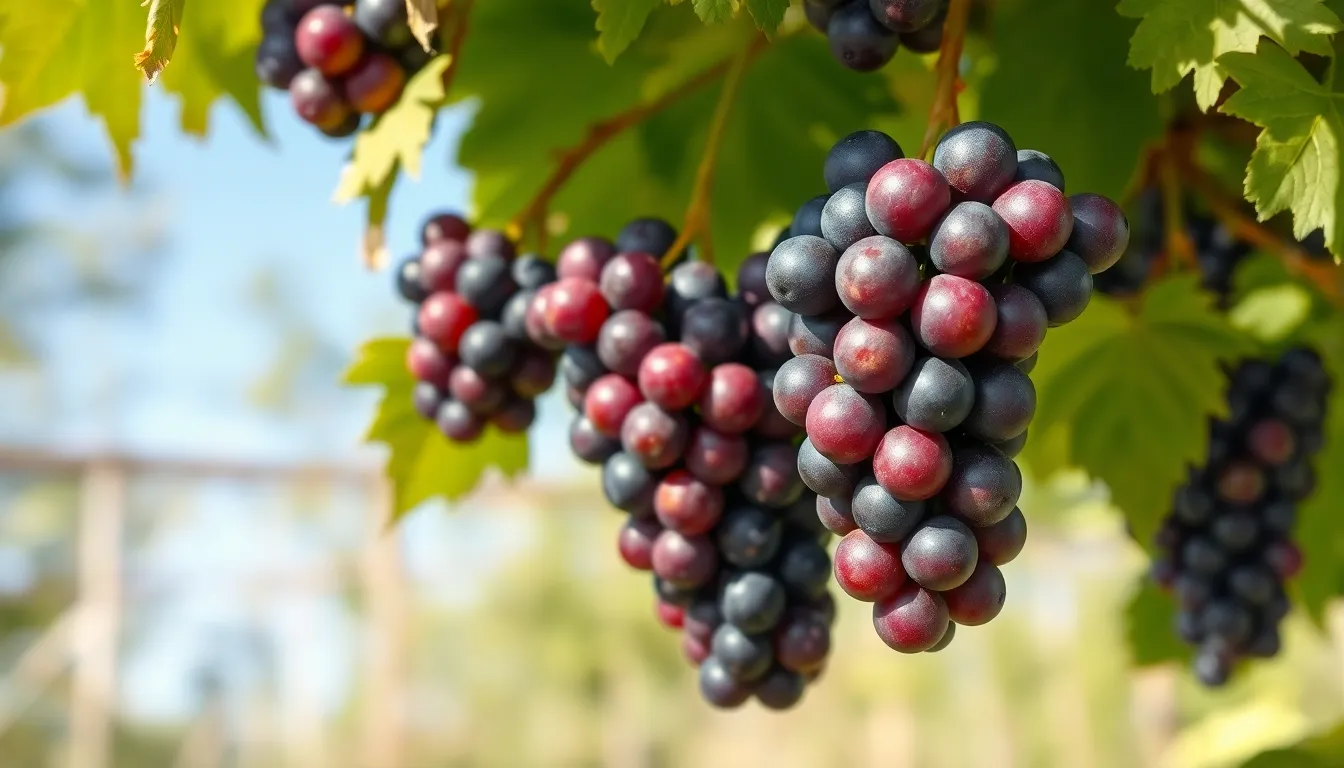
Muscadine grapes reach their prime ripeness in late summer to early fall across the southeastern United States. The peak harvesting season typically runs from August through October depending on your exact location and the weather patterns of that particular year. During this period muscadines develop their characteristic deep purple or bronze coloration along with maximum sugar content and flavor intensity.
Southern states experience slightly different muscadine seasons. Florida and Georgia often see the first ripe muscadines in early August while North Carolina and Virginia harvests might extend into mid-October. The further north you go the shorter and later the season tends to be.
Temperature plays a crucial role in muscadine ripening. These grapes require several consecutive days of temperatures above 85°F to develop their full sweetness and distinctive musky aroma. A sudden cold snap can halt the ripening process prematurely affecting flavor development.
Rainfall patterns also impact the quality of muscadine harvests. While these hardy grapes tolerate drought conditions better than many cultivated varieties excessive rain near harvest time can dilute flavors and potentially split the fruits. Ideally muscadines benefit from moderate rainfall throughout summer followed by drier conditions as they approach ripeness.
For jelly making purposes muscadines are best harvested when fully ripe but still firm. They should detach easily from the vine when gently twisted a sign that they’ve reached optimal ripeness. The skins will have developed their deep color but should remain intact with no splits or signs of fermentation.
Local farmers markets offer excellent opportunities to purchase fresh muscadines during season if you don’t grow your own. Many small farms and vineyards throughout the South offer U-pick options allowing you to select perfectly ripe specimens for your jelly making endeavors.
Wild muscadines found growing along forest edges or old fence rows reach ripeness slightly later than cultivated varieties. These wild grapes often possess more intense flavors and higher natural pectin content making them particularly prized for traditional jelly recipes.
Planning your jelly making session during peak season ensures you’ll capture the most vibrant flavor in your preserves. The natural pectin levels reach their height in just-ripened fruit making late summer to early fall the ideal time for putting up muscadine jelly for the year ahead.
Conclusion
Muscadine jelly stands as a testament to Southern heritage and ingenuity. By transforming these distinctive wild grapes into a jewel-toned preserve you’re not just making jelly – you’re continuing a cherished tradition.
Whether spread on warm biscuits paired with sharp cheese or used to glaze holiday meats your homemade muscadine jelly will showcase flavors that simply can’t be found in store-bought varieties.
Armed with the right tools simple ingredients and helpful troubleshooting tips you’ll confidently create this seasonal delicacy. The true reward comes when you open a jar in winter and taste summer’s essence captured in that perfect sweet-tart balance that only muscadines provide.
So when late summer arrives grab your baskets and head for the vines – muscadine season awaits!
Frequently Asked Questions
What is muscadine jelly?
Muscadine jelly is a Southern delicacy made from wild muscadine grapes (Vitis rotundifolia) that grow throughout the southeastern United States. It features a distinctive sweet-tart flavor with a smooth, spreadable texture and jewel-tone color ranging from deep purple to ruby red. This traditional preserve captures the unique musky sweetness of muscadines and transforms them into a versatile condiment that’s been enjoyed for generations.
When is the best time to make muscadine jelly?
The ideal time to make muscadine jelly is from late August through October when these wild grapes reach peak ripeness. During this late summer to early fall period, muscadines develop their full flavor and color, whether deep purple or bronze. For the best results, look for fully ripe grapes at local farmers markets, U-pick farms, or forage from wild vines if you’re familiar with identifying them.
What equipment do I need to make muscadine jelly?
Essential equipment includes a large pot for cooking the jelly, a food mill or jelly bag for straining the juice, measuring cups and spoons, a candy thermometer, canning jars with new lids and rings, and a water bath canner. You’ll also need basic kitchen tools like a potato masher for crushing grapes, a ladle for filling jars, and a funnel. Ensure all equipment is clean and sterilized before starting.
Can I make muscadine jelly without added pectin?
Yes, you can make muscadine jelly without commercial pectin because muscadines naturally contain more pectin than regular grapes. For a no-added-pectin recipe, you’ll need to cook the juice longer until it reaches the gel stage (220°F at sea level). Testing the consistency using the cold plate method helps ensure proper setting. However, using added pectin creates more reliable results and shortens cooking time.
How long does homemade muscadine jelly last?
Properly sealed jars of muscadine jelly can be stored at room temperature for up to 12 months. Once opened, refrigerate the jelly and use it within 3 weeks. Always check for signs of spoilage before consuming, such as mold, off odors, or unusual discoloration. For longer preservation, you can freeze unopened jars, though this might slightly affect the texture upon thawing.
Why didn’t my muscadine jelly set properly?
Jelly that doesn’t set properly usually results from insufficient pectin, inadequate acid, improper sugar proportions, or undercooked jelly. Ensure you’re using the correct measurements of lemon juice and sugar per the recipe. Muscadines’ natural pectin content varies, so adding commercial pectin helps ensure consistent results. If your jelly is too runny, you can often fix it by recooking with additional pectin.
What are some ways to serve muscadine jelly?
Muscadine jelly is incredibly versatile. Spread it on warm biscuits, toast, or pancakes for breakfast. Pair it with cheese on a charcuterie board, especially with sharp cheddar or brie. Use it as a glaze for ham, pork, or chicken. Incorporate it into thumbprint cookies or as an ice cream topping. Stir it into yogurt or oatmeal, or use it as a filling for layer cakes. Its unique flavor complements both sweet and savory dishes.
Can I use different types of muscadines for jelly?
Absolutely! Both purple (black) and bronze (scuppernong) varieties of muscadines work wonderfully for jelly. Purple muscadines typically produce a deeper-colored jelly with a more intense flavor, while bronze varieties create a lighter, sometimes more delicate taste. You can use a single variety or mix them for a unique flavor profile. The jelly color will reflect the grapes used.
Why is my muscadine jelly cloudy?
Cloudy jelly typically results from improper straining that allows pulp or sediment into the juice. For crystal-clear jelly, strain the juice through several layers of cheesecloth or a jelly bag without squeezing (though this reduces yield). Another cause could be premature pouring into jars before skimming off foam, or waiting too long to pour after the jelly reaches setting point, allowing pectin to start settling.
Can I reduce the sugar in muscadine jelly?
Traditional muscadine jelly recipes use significant sugar to achieve proper setting, preserve color, and balance the grapes’ natural tartness. Substantially reducing sugar can prevent proper gel formation when using regular pectin. If you prefer less sweetness, use a low-sugar or no-sugar-needed pectin formulation specifically designed for reduced sugar recipes, and follow the manufacturer’s instructions precisely for the best results.
